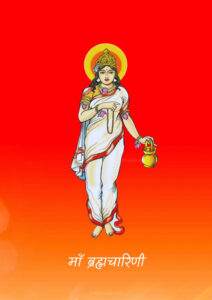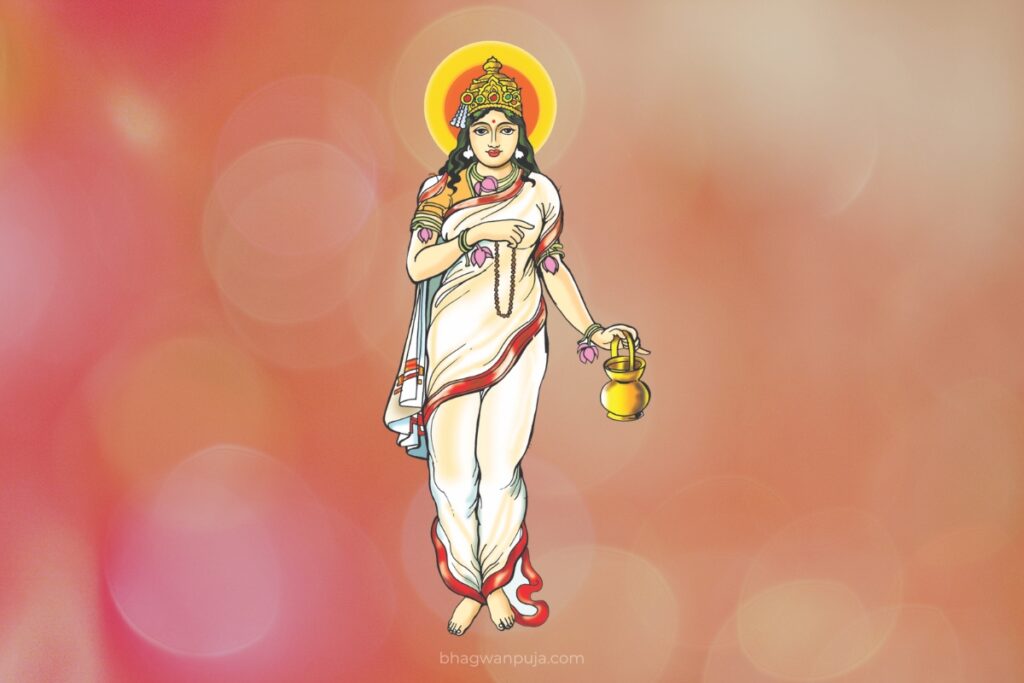Navratri, a festival celebrated over nine days, holds profound significance in Hindu culture. Each of these nine days is dedicated to one of the nine divine forms of Goddess Parvati or Maa Durga and is observed with unwavering devotion. The second day of Navratri is dedicated to Goddess Brahmacharini Maa, the second divine form of Maa Parvati. The name “Brahmacharini” signifies “Brahma” (penance) and “Charini” (behavior), denoting Maa Brahmacharini as Devi Yogni and Devi Tapsvini.
Day 2 of Navratri: Goddess Brahmacharini Puja and Date
The depiction of Goddess Brahmacharini involves her holding a Kamandal (water pot) in her left hand, a Japa mala (prayer beads) in her right hand, adorned in a white saree with a bright orange border and Rudraksha beads as ornaments. She symbolizes love, loyalty, knowledge, wisdom, and single-minded dedication. She is associated with the Swadhisthana Chakra and governs the planet Mars (Mangal).
Rituals for Worshipping Goddess Brahmacharini in 2024
- Date: Friday, October 4, 2024 (Day 2)
- Color: Orange
- Mantra: “Om Braam Breem Broom Brahmacharini Namah”
History of Worshiping Maa Brahmacharini on the Second Day of Navratri
 According to legend, Goddess Parvati’s earlier incarnation was Devi Sati. She had self-immolated due to the disrespect and insult her husband, Lord Shiva, suffered at the hands of her father, Dakshya. She yearned for Lord Shiva as her husband, but he was deeply engrossed in meditation for an extended period. Naradji advised Goddess Parvati to undertake severe austerity and perform extreme penance, which she diligently followed for a thousand years.
According to legend, Goddess Parvati’s earlier incarnation was Devi Sati. She had self-immolated due to the disrespect and insult her husband, Lord Shiva, suffered at the hands of her father, Dakshya. She yearned for Lord Shiva as her husband, but he was deeply engrossed in meditation for an extended period. Naradji advised Goddess Parvati to undertake severe austerity and perform extreme penance, which she diligently followed for a thousand years.
Meanwhile, the Devas (demi-gods) sought Kamadeva, the God of love, to kindle desire in Lord Shiva’s heart for Parvati. This was crucial because a demon named Tarkasur was causing havoc in the celestial realm, and only Lord Shiva’s son could defeat him. However, Lord Shiva was in profound meditation, and arousing his desire for Parvati was essential. Kamadeva attempted this but, when Lord Shiva was disturbed in his meditation, he assumed his fierce Rudra form, and Kamadeva was reduced to ashes.
On the other hand, Maa Parvati endured immense penance for thousands of years, sustaining herself by consuming only Bilva leaves. She remained resolute in her focus on Lord Shiva during this time, and she was known as Brahmacharini. Mata Brahmacharini immersed herself in the worship of Lord Shiva.
When Lord Shiva became aware of Mata Brahmacharini’s intense penance, he visited her and tried to dissuade her from the perilous path of tapasya (austerity). However, she persisted in her penance. Eventually, Lord Shiva accepted her as his wife, and they were united. In this manner, the divine Mother fully devoted herself to the worship of Lord Shiva, earning her the name “Brahmacharini.”
Significance of Maa Brahmacharini Puja
On the second day of Navratri, the worship of Goddess Brahmacharini is essential as her grace empowers us to move forward in life, even in the face of numerous challenges. She blesses us with emotional strength, ensuring a balanced mental state, and the confidence to navigate through the darkest of times. Goddess Brahmacharini inspires us to uphold our ethical values and walk the path of duty with sincerity and truthfulness. Brahmacharini Maa epitomizes love and loyalty, and she is a repository of knowledge and wisdom, with Rudraksha beads as her favored ornaments.
Conclusion
Worshipping Goddess Brahmacharini on the second day of Navratri invites the loving blessings of the Divine Mother. Praying to her with unwavering devotion promises rich benefits. She imparts the strength to forge ahead in life, irrespective of challenging circumstances, bringing a sense of calmness and self-confidence. The worship of Brahmacharini Mata bestows knowledge and wisdom and eliminates fear from our lives.
